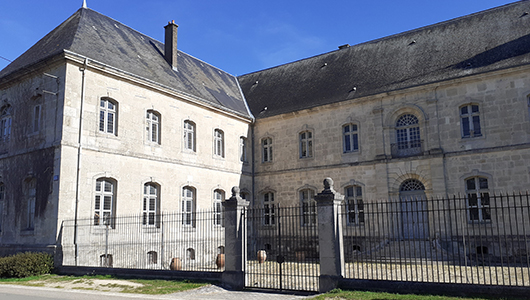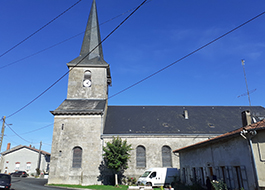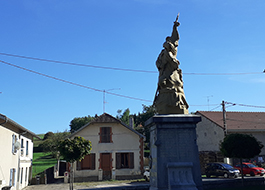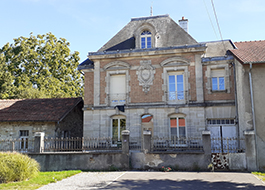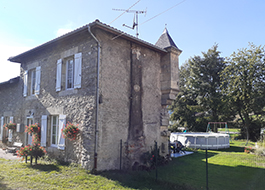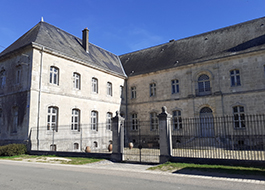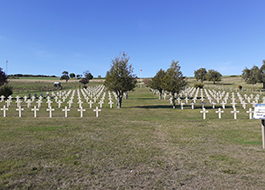Brieulles-sur-Meuse
Durée visite : 90 minutes
Moyen : Pédestre
Le bourg a toujours été un point fortifié sur la rive gauche de la Meuse. Ce qui lui a valu d’être saccagé en 1552 par Charles Quint, en 1582 et 1588 pendant les guerres de Religion, en 1622 et 1636 durant la guerre de Trente Ans, puis pendant la Première Guerre mondiale. Ce qui ne dissuade pas le sire de Cadenet, conseiller de Louis XIII, d’y fonder un prieuré de Prémontrés.
The town has always been a fortified point on the left bank of the Meuse. Which earned him to be ransacked by Charles V in 1552, in 1582 and 1588 during the Wars of Religion, in 1622 and 1636 during the Thirty Years War, then during the First World War. This did not deter the Sire de Cadenet, adviser to Louis XIII, from founding a priory of Prémontrés there.
Die Stadt war schon immer ein befestigter Punkt am linken Ufer der Maas. 1552, 1582 und 1588 während der Religionskriege, 1622 und 1636 während des Dreißigjährigen Krieges, dann während des Ersten Weltkriegs wurde er von Karl V. geplündert. Dies hielt Sire de Cadenet, Berater Ludwigs XIII., nicht davon ab, dort ein Priorat der Prémontrés zu gründen.

De gueules à deux crosses d’or passées en sautoir ; coupé abaissé d’azur au lis de jardin d’or, tigé et feuillé de même ; au pont d’argent gardé par deux tours du même, mouvant des flancs et brochant sur la partition.
Gules with two golden butts passed in saltire ; cut lowered from azure to the lily of garden of gold, stemmed and leafy of the same; at the silver bridge guarded by two towers of the same, moving from the sides and skewing on the partition.
Gules mit zwei goldenen Hintern in Saltire bestanden; Schnitt von azurblau auf die Lilie des Gartens aus Gold, gestielt und belaubt derselben; an der silbernen Brücke, die von zwei Türmen derselben bewacht wird, die sich von den Seiten bewegen und an der Trennwand schräg sind.

Les habitants de Brieulles-sur-Meuse s’appellent les Brieulans et les Brieulanes.
Inhabitants of Brieulles-sur-Meuse are called Brieulans and Brieulanes.
Die Einwohner von Brieulles-sur-Meuse werden Brieulans und Brieulanes genannt.
Les points de visites
.
Ce petit pont a la particularité d’offrir une ouverture dans sa rambarde, afin d’y puiser de l’eau.
This small bridge has the particularity of offering an opening in its railing, in order to draw water from it.
.
Elle date de 1774 et est de style néo-classique. Quatre bas-reliefs représentent des épisodes de la vie de la Vierge. Ils ont été sculptés par Firmin Arnuld en 1695, pour l’ancien maître-autel. Un vitrail évoque le sacrifice des Américains et des Français, pour libérer la région en 1918. L’Assomption, appelée Dormition dans la tradition orientale, est la croyance chrétienne selon laquelle la Vierge Marie, mère de Jésus, est entrée directement dans la gloire de Dieu, autrement dit montée au ciel, au terme de sa vie terrestre. Sans fondement biblique, mais conforme à une tradition très ancienne des Églises d’Orient comme d’Occident, cette croyance est une fête liturgique depuis le VIIIe siècle. Dans le catholicisme, elle a été définie comme dogme par Pie XII en 1950.
It dates from 1774 and is neo-classical in style. Four bas-reliefs represent episodes from the life of the Virgin. They were sculpted by Firmin Arnuld in 1695, for the old high altar. A stained glass window evokes the sacrifice of the Americans and the French, to liberate the region in 1918. The Assumption, called Dormition in the Eastern tradition, is the Christian belief that the Virgin Mary, mother of Jesus, entered directly into the glory of God, in other words ascended into heaven, at the end of her earthly life. Without biblical basis, but in accordance with a very ancient tradition of the Eastern and Western Churches, this belief has been a liturgical feast since the 8th century. In Catholicism, it was defined as a dogma by Pius XII in 1950.
Es stammt aus dem Jahr 1774 und ist im neoklassizistischen Stil gehalten. Vier Flachreliefs stellen Episoden aus dem Leben der Jungfrau dar. Sie wurden 1695 von Firmin Arnuld für den alten Hochaltar gemeißelt. Ein Buntglasfenster erinnert an das Opfer der Amerikaner und Franzosen zur Befreiung der Region im Jahr 1918. Die Himmelfahrt, in der östlichen Tradition Dormitio genannt, ist der christliche Glaube, dass die Jungfrau Maria, die Mutter Jesu, am Ende ihres irdischen Lebens direkt in die Herrlichkeit Gottes eingegangen ist, also in den Himmel aufgefahren ist. Ohne biblische Grundlage, aber in Übereinstimmung mit einer sehr alten Tradition der Ost- und Westkirchen, ist dieser Glaube seit dem 8. Jahrhundert ein liturgisches Fest. Im Katholizismus wurde es 1950 von Pius XII. als Dogma definiert.
.
Brieulles possède encore 5 lavoirs publics qui ont résisté au temps et aux guerres. Ils datent du XIXe siècle, époque où la commune comptait un millier d’habitants. Il en reste 305 en 2019. Ils ont été restaurés. Celui-ci est original avec sa façade à pans coupés. Alimenté à l’origine par une source, il l’est depuis par une adduction d’eau communale.
Brieulles still has 5 public washhouses that have stood the test of time and wars. They date from the 19th century, when the town had a thousand inhabitants. There are 305 left in 2019. They have been restored. This one is original with its cut-off facade. Originally supplied by a spring, it has since been supplied by a municipal water supply.
Brieulles hat noch 5 öffentliche Waschhäuser, die die Zeit und Kriege überdauert haben. Sie stammen aus dem 19. Jahrhundert, als die Stadt tausend Einwohner hatte. Im Jahr 2019 sind noch 305 übrig. Sie wurden restauriert. Dieser hier ist originell mit seiner abgeschnittenen Fassade. Ursprünglich aus einer Quelle gespeist, wird es seitdem von einer kommunalen Wasserversorgung versorgt.
.
Un Poilu est représenté tête haute, le genou sur son sac à dos, tenant son drapeau. Le sculpteur est Charles Breton. Il réalise 58 monuments aux morts. C’est la célèbre Fonderie du Val d’Osne qui a fabriqué le bronze. Le monument est dédié aux 78 habitants de Brieulles, morts en captivité ou loin de leurs foyers. 44 noms sont inscrits pour les soldats tombés dans les deux guerres mondiales. Les frères Huart, tous deux fantassins sont morts pour la France : Ernest, en Belgique le 22 août 1914, journée la plus sanglante de l’histoire militaire française, avec 27000 tués ; Léon à Douaumont, le 1er mars 1916. Ils avaient 20 et 21 ans. Paul Vitry est tué dans la célèbre tranchée de Craonne, sur le Chemin des Dames, en avril 1917.
A Poilu is represented with his head held high, his knee on his backpack, holding his flag. The sculptor is Charles Breton. He created 58 war memorials. The famous Val d’Osne Foundry made the bronze. The monument is dedicated to the 78 inhabitants of Brieulles, who died in captivity or far from their homes. 44 names are inscribed for soldiers who fell in the two world wars. The Huart brothers, both infantrymen died for France: Ernest, in Belgium on August 22, 1914, the bloodiest day in French military history, with 27,000 killed; Léon in Douaumont, March 1, 1916. They were 20 and 21 years old. Paul Vitry was killed in the famous Craonne trench, on the Chemin des Dames, in April 1917.
Ein Poilu wird mit erhobenem Kopf dargestellt, sein Knie auf seinem Rucksack und seine Flagge haltend. Der Bildhauer ist Charles Breton. Er schuf 58 Kriegerdenkmäler. Die berühmte Gießerei Val d’Osne hat die Bronze hergestellt. Das Denkmal ist den 78 Einwohnern von Brieulles gewidmet, die in Gefangenschaft oder weit weg von ihren Häusern starben. 44 Namen von Soldaten, die in den beiden Weltkriegen gefallen sind, sind eingraviert. Die Brüder Huart, beide Infanteristen, starben für Frankreich: Ernest in Belgien am 22. August 1914, dem blutigsten Tag in der französischen Militärgeschichte, mit 27.000 Toten; Léon in Douaumont, 1. März 1916. Sie waren 20 und 21 Jahre alt. Paul Vitry wurde im April 1917 im berühmten Graben von Craonne am Chemin des Dames getötet.
.
Cette maison, en style néo-classique, de 1924 date de la reconstruction du village. Noter les diverses pierres utilisées, pour les différents étages. Peut-être a-t-elle été financée par les dons reçus du 9e arrondissement de Paris ? En effet, son conseil municipal avait voté une aide pour Brieulles, en 1921.
This house, in neo-classical style, from 1924 dates from the reconstruction of the village. Note the various stones used for the different floors. Perhaps it was financed by donations received from the 9th arrondissement of Paris? Indeed, its municipal council had voted an aid for Brieulles, in 1921.
Dieses Haus im neoklassizistischen Stil aus dem Jahr 1924 stammt aus dem Wiederaufbau des Dorfes. Beachten Sie die verschiedenen verwendeten Steine für die verschiedenen Böden.
Vielleicht wurde es durch Spenden aus dem 9. Arrondissement von Paris finanziert? Tatsächlich hatte der Gemeinderat 1921 eine Beihilfe für Brieulles beschlossen.
.
Un oriel est une fenêtre en encorbellement, aménagée sur un ou plusieurs niveaux d’une façade. Quand l’oriel est fermé par une porte intérieure, on parle de « balcon-serre » Un oriel peut épouser différents aspects et formes (de deux à six faces) et être surmonté d’un toit ou d’une petite terrasse avec garde-corps. Des communes ayant instauré une taxe foncière calculée sur l’emprise au sol, des contribuables malins avaient recours à cette construction astucieuse. Ils augmentaient ainsi leur surface habitable, sans surcoût d’impôt.
An oriel is a corbelled window, arranged on one or more levels of a facade. When the oriel is closed by an interior door, it is called a « balcony-greenhouse ». An oriel can take on different aspects and shapes (from two to six sides) and be surmounted by a roof or a small terrace with body. Municipalities having established a property tax calculated on the footprint, clever taxpayers had recourse to this clever construction. They thus increased their living space, without additional tax costs.
Ein Erker ist ein Kragfenster, das auf einer oder mehreren Ebenen einer Fassade angeordnet ist. Wenn der Erker durch eine Innentür verschlossen ist, spricht man von einem „Balkon-Gewächshaus ». Ein Erker kann verschiedene Aspekte und Formen annehmen (von zwei bis sechs Seiten) und von einem Dach oder einer kleinen Terrasse mit Körper überragt werden.
Kommunen, die eine nach dem Fußabdruck berechnete Grundsteuer eingeführt hatten, griffen clevere Steuerzahler auf diese clevere Konstruktion zurück. Sie vergrößerten damit ihren Wohnraum, ohne zusätzliche Steuerkosten.
.
Le prieuré des Prémontrés, dont le premier bâtiment est construit pour les Prémontrés dans les années 1645-1655, est reconstruit en grande partie en 1754 et 1756. Avant la Révolution, il appartenait aux prémontrés ou aux religieux réformés de l’ordre de Saint-Augustin. 8 religieux s’y partageaient un revenu de 3000 livres. Confisqué et vendu après 1789, le bâtiment est utilisé comme école au XIXe siècle. Un tiers de l’édifice est employé à cet office, après les réparations consécutives à la guerre de 1914. Le reste n’est restauré qu’à la fin du XXe, par une association pilotée par le maire.
The Prémontrés priory, the first building of which was built for the Prémontrés in the years 1645-1655, was largely rebuilt in 1754 and 1756. Before the Revolution, it belonged to the premonstratensians or the reformed religious of the order of Saint-Augustin. 8 monks shared an income of 3000 pounds. Confiscated and sold after 1789, the building was used as a school in the 19th century. A third of the building was used for this office, after repairs following the war of 1914. The rest was not restored until the end of the 20th century, by an association led by the mayor.
Das Priorat der Prémontrés, dessen erstes Gebäude in den Jahren 1645-1655 für die Prémontrés errichtet wurde, wurde 1754 und 1756 weitgehend umgebaut. Vor der Revolution gehörte es den Prämonstratensern oder den reformierten Ordensleuten des Augustinerordens. 8 Mönche teilten sich ein Einkommen von 3000 Pfund. Nach 1789 beschlagnahmt und verkauft, diente das Gebäude im 19. Jahrhundert als Schule. Ein Drittel des Gebäudes wurde nach Reparaturen nach dem Krieg von 1914 für dieses Büro genutzt. Der Rest wurde erst Ende des 20. Jahrhunderts von einem Verein unter der Leitung des Bürgermeisters restauriert.
.
Le cimetière allemand de Brieulles-sur-Meuse a été créé dès le début de la Grande Guerre. On y inhuma, dans un premier temps, les dépouilles des soldats du 13e régiment d’infanterie. Après la Bataille de Verdun et les combats d’Argonne, on y inhuma les corps de soldats d’autres unités de l’armée allemande. Ce cimetière est le plus importante nécropole allemande de la Meuse. Elle renferme 5953 tombes individuelles et plusieurs ossuaires contenant 5324 corps de militaires non-identifiés. Il est marqué, comme tous les cimetières militaires allemands, par la simplicité et la sobriété. Le cimetière allemand a fait l’objet d’un réaménagement en 1972. Les croix en bois y ont été remplacées par des croix en métal, portant les noms des soldats et la date de leur décès.
The German cemetery of Brieulles-sur-Meuse was created at the start of the Great War. Initially, the remains of the soldiers of the 13th Infantry Regiment were buried there. After the Battle of Verdun and the battles of Argonne, the bodies of soldiers from other units of the German army were buried there. This cemetery is the most important German necropolis of the Meuse. It contains 5953 individual graves and several ossuaries containing 5324 bodies of unidentified soldiers. It is marked, like all German military cemeteries, by simplicity and sobriety. The German cemetery was refurbished in 1972. The wooden crosses were replaced by metal crosses, bearing the names of the soldiers and the date of their death.
Der deutsche Friedhof von Brieulles-sur-Meuse wurde zu Beginn des Ersten Weltkriegs angelegt. Zunächst wurden dort die Überreste der Soldaten des 13. Infanterieregiments begraben. Nach der Schlacht von Verdun und den Schlachten von Argonne, wurden die Leichen von Soldaten anderer Einheiten der deutschen Armee dort begraben. Dieser Friedhof ist die bedeutendste deutsche Nekropole an der Maas. Es enthält 5953 Einzelgräber und mehrere Beinhäuser mit 5324 Leichen nicht identifizierter Soldaten. Er ist, wie alle deutschen Soldatenfriedhöfe, von Schlichtheit und Nüchternheit geprägt. Der Deutsche Friedhof wurde 1972 saniert. Die Holzkreuze wurden durch Metallkreuze ersetzt, die die Namen der Soldaten und das Todesdatum tragen.
.
L’existence de ce cimetière est consécutive aux combats dans le nord meusien. Sur 8015 m2, 1052 tombes de soldats, français pour la plupart, mais aussi belges (35) russes (123) anglais (un sergent), y sont regroupées. Il est complété par deux ossuaires renfermant les restes de 1520 soldats français non-identifiés. 24 soldats français de 39-45 sont également présentes. Toutes les croix ont, à leur pied, un rosier nain qui donne, l’été, une note moins austère à la nécropole. 5000 russes sont morts en France durant la Première Guerre mondiale. Ils faisaient partie d’un corps expéditionnaire, envoyé par le Tsar en 1916, pour seconder l’allié français.
The existence of this cemetery is consecutive to the fighting in the north of Meuse. On 8015 m2, 1052 graves of soldiers, French for the most part, but also Belgian (35) Russian (123) English (a sergeant), are grouped there. It is completed by two ossuaries containing the remains of 1520 unidentified French soldiers. 24 French soldiers from 39-45 are also present. All the crosses have, at their foot, a dwarf rosebush which, in summer, gives a less austere note to the necropolis. 5000 Russians died in France during the First World War. They were part of an expeditionary force, sent by the Tsar in 1916, to assist the French ally.
Die Existenz dieses Friedhofs geht auf die Kämpfe im Norden der Maas zurück. Auf 8015 m2 gruppieren sich dort 1052 Gräber von Soldaten, größtenteils Franzosen, aber auch Belgier (35) Russen (123) Engländer (ein Feldwebel). Es wird durch zwei Beinhäuser vervollständigt, die die Überreste von 1520 nicht identifizierten französischen Soldaten enthalten. 24 französische Soldaten von 39-45 sind ebenfalls anwesend. Alle Kreuze haben zu ihren Füßen einen Zwergrosenstrauch, der der Nekropole im Sommer eine weniger strenge Note verleiht. 5000 Russen starben während des Ersten Weltkriegs in Frankreich. Sie waren Teil einer Expeditionstruppe, die 1916 vom Zaren entsandt wurde, um den französischen Verbündeten zu unterstützen.

